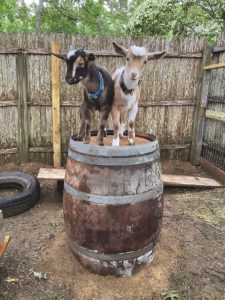When we bred our doe, Buttercup, for the first time, we were novice goat keepers. We rented a buck, Stinky Dan, whose musky aroma was nothing out of the ordinary for a buck, from another backyard farm.
The price, we were told, would be one of the kids, which made sense at the time of the bargain, since Stinky Dan was, after all, to be the dad. When Dan’s owner threw in the promise of her knowledgeable presence at the birth, that sealed the deal for us.
On birthing day, we learned that, with every bargain, even a backyard farm barter, it’s crucial to study the fine print. We had assumed that the promised kid would leave our farm when he or she was weaned from our doe. But my hands were still wet from placing twin newborns at their mama’s side when I learned we were to give up the female later that very day.

The kid would be bottle fed at her new home, and our doe would be left with just one of her babies to raise. “It’s best that she doesn’t get too attached,” we were told. Though separation at birth is practiced at many dairy farms, my heart shattered as I watched Buttercup’s newborn being carried away. Our Buttercup was not herself for days, searching for her baby girl.
I was determined to do things differently when we decided to breed Buttercup for a second time. We bought our very own buck, handsome Lance Romance. I researched mother-baby attachment among goats. Not only would these kids go to a loving home, they would leave our farm at the optimal time.
Does form strong bonds with their kids when they sniff and clean them after birth. According to scientists at Queen Mary, University of London, a doe can identify the sound of her own kids’ bleats even after more than a year of separation.
The best time to rehome kids, I learned, is between 8 and 12 weeks — when they are old enough to be weaned, yet young enough to adjust to a new home and form strong attachments to their new owners.
Goats are sociable herd animals and should not live alone. So, we set out to find a family that would want both of Buttercup’s kids. Males are not as sought after as females in the world of backyard goat herding — we all have our cheesemaking dreams. But while keeping a buck takes special devotion, a couple of relatively sweet-smelling wethers, or former bucks, could be a lot of fun.
Nicole Snow and Robert Ryan came from Brewster to meet the new kids the day after they were born. It was a good sign that they petted Buttercup and gave her treats. They gave the kids their names — Willy and Zevon — and continued visiting for a few months as we gradually weaned them.
Starting when they were two weeks old, the kids spent part of each day away from Buttercup. At that point, they were ready to taste some hay and grain, reducing their milk intake as they ranged more. We increased that time apart until we were confident the kids were ready to be separated from their mother.
Although my early attempts at milking hadn’t gone well, after Willie and Zevon left for their new home, I milked Buttercup once a day for a few days to make sure the last of her milk wouldn’t lead to mastitis, an infection of the milk ducts. The risk of that is high during weaning, when there is more milk in the mammary glands than the kids need.
On the day of Willie’s and Zevon’s departure, we saw Buttercup snuggling with Puck, her kid born the year before. We were all a little sad, but this experience was nothing like last year’s.
Soon, there was news from Brewster: “The boys have adapted well,” Nicole told us. “Robert brought a chair into the pen,” she added. When she described how she would come home from work and find him sitting in there with the kids jumping around him, we knew we’d chosen their new family well.



